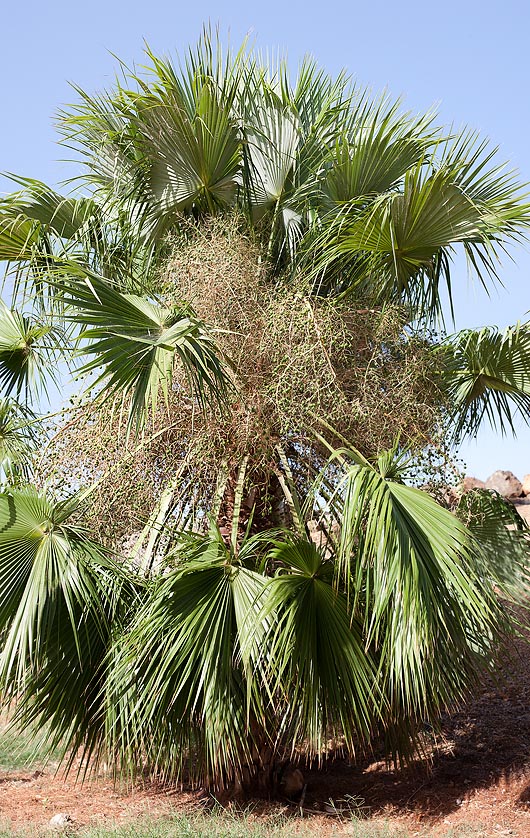Family : Arecaceae

Text © Pietro Puccio

English translation by Mario Beltramini

A Brahea brandegeei full of edible fruits. Resists well to cold © Giuseppe Mazza
The species is native to the semi-arid zones of North-western Mexico (Baja California and Sonora), where it grows on the mountain slopes and in rocky canyons where water is present, at medium altitude.
The genus is honoured to the Danish astronomer Tycho Brahe (1546-1601), the species to the American engineer and botanist Townshend Stith Brandegee (1843-1925).
Common names: Brandegee palm, San José hesper palm (English); palmier de Brandegee, palmier de San José (French); palma de taco, palma negra, palmilla (Spanish – Mexico).
Brahea brandegeei (Purpus) H.E.Moore (1975) is a species with a single stem tall up to about 15 m, with a diameter of 30-40 cm, of greyish brown colour partly covered by the persistent dry leaves.
Costapalmate leaves of green colour on the upper page, glaucous green below, 1-1,4 m broad, divided for about half of the length into thin, rigid segments, bifid at the apex; 1-1,3 m long petiole and about 3 cm broad in the median part, irregularly tomentose close to the base, with margins equipped with robust spines of pale yellow colour, about 0,6 cm long.
Inflorescences among the leaves, slightly shorter than the same, arcuate, ramified, carrying hermaphrodite flowers of cream white colour. Oblong-globose fruits, 1,5-2,2 cm long, when ripe of glossy brown colour, at times with paler striations, edible, when still unripe and of yellowish colour, with taste similar to that of the dates, and consumed by the local populations, who call them “tacos”.
Brahea brandegeei was assessed in 2014 by The IUCN Red List of Threatened Species in the category of “LC, Least Concern”.
It reproduces by seed which germinates in 3-6 months with bottom heat.
Considered as amongst the most ornamental of the genus, of fairly fast growth, is still little cultivated probably due to a certain resemblance to the Washingtonia robusta, faster in the growth and more easily available.
It is cultivable in the tropical, subtropical climate zones and warm temperate, where it seems it can resist, when adult, to temperatures as low as about -8 °C, for a very short period, but the foliage gets damages already by around the -4/-5 °C. It requires full sun and very good drainage, for the rest it adapts to poor soils, alkaline, and when adult it can bear long drought periods, but takes advantage from regular waterings, especially in the juvenile stage, in the zones characterized by long warm and dry summers; it does not love too much humid climates, even if it stands amongst the most tolerant of the genus on this point of view.
Synonyms: Erythea brandegeei Purpus (1903); Glaucothea brandegeei (Purpus) I.M.Johnst. (1924).
→ For general notions about ARECACEAE please click here.
